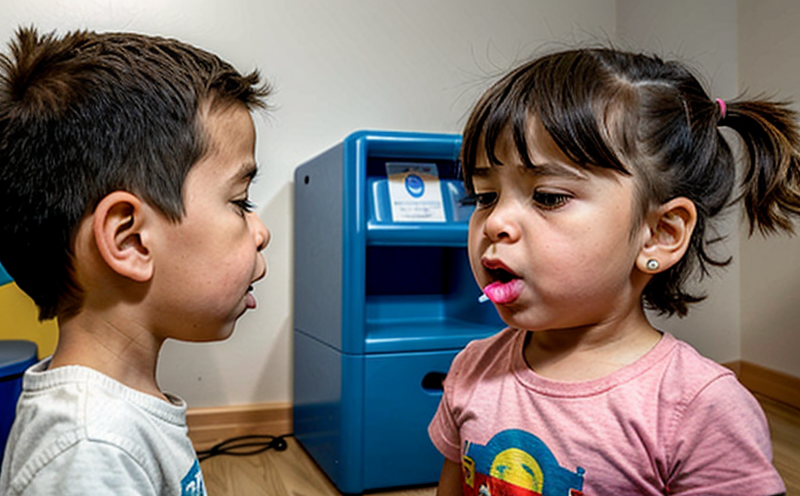Simulating child interactions to test whether small parts can be easily pulled off and swallowed
Title Safeguarding Children with Simulated Interactions Why Eurolabs Service is Essential for Businesses
Introduction
As a parent, the thought of your child ingesting small parts from toys, furniture, or other products can be a terrifying one. The risks are very real, and the consequences can be severe. According to the American Academy of Pediatrics (AAP), each year thousands of children visit emergency rooms due to swallowing non-food items, with small parts being a leading cause. This is why businesses must take proactive steps to ensure their products meet strict safety standards. At Eurolab, we offer a critical laboratory service that simulates child interactions to test whether small parts can be easily pulled off and swallowed.
This innovative approach not only helps prevent accidents but also saves lives by ensuring companies comply with regulatory requirements. Our team of experts at Eurolab has developed a comprehensive testing protocol that mimics the way children interact with products, from toddlers who love to put everything in their mouths to older kids who enjoy taking things apart.
The Importance of Simulating Child Interactions
In todays competitive market, businesses must prioritize product safety while also meeting regulatory demands. The U.S. Consumer Product Safety Commission (CPSC) requires companies to test their products for small parts and other hazards. Non-compliance can result in costly recalls, damaged brand reputation, and even lawsuits.
Eurolabs simulated child interactions testing service addresses these concerns by providing a comprehensive evaluation of your products safety. Our experts assess how easily small parts can be detached from the main component, simulating various scenarios that mimic real-life situations.
Advantages of Using Simulated Child Interactions to Test Small Parts
Our laboratory service offers numerous benefits for businesses
Reduced Recall Costs By identifying potential hazards early on, you can avoid costly recalls and minimize financial losses.
Improved Brand Reputation Demonstrating a commitment to product safety enhances your brands image and fosters customer trust.
Compliance with Regulatory Requirements Our testing ensures you meet or exceed CPSC standards, avoiding non-compliance fines and penalties.
Enhanced Product Design The insights gained from our simulations can inform design changes, resulting in safer products that better meet consumer needs.
Key Benefits of Eurolabs Service
Our simulated child interactions testing service offers numerous advantages
Thorough Evaluation Our comprehensive assessment ensures a thorough understanding of your products safety profile.
Timely Insights We provide quick turnaround times, allowing you to make informed decisions about design changes or recalls.
Expert Analysis Our team consists of experienced professionals who can interpret results and offer recommendations for improvement.
QA
Q How does Eurolab simulate child interactions?
A Our expert technicians mimic various scenarios that reflect real-life situations, from toddlers exploratory behavior to older kids tendency to take things apart.
Q What types of products are tested?
A We test a wide range of products, including toys, furniture, electronics, and other consumer goods with small parts.
Q How long does the testing process typically take?
A The duration varies depending on the product complexity and testing requirements. Our team provides timely insights to ensure you can make informed decisions about design changes or recalls.
Q Can I request specific testing scenarios?
A Yes, we work closely with clients to tailor our testing protocols to meet their unique needs and regulatory requirements.
Conclusion
In todays fast-paced market, businesses must prioritize product safety while meeting strict regulatory demands. Eurolabs simulated child interactions testing service is an essential tool for companies seeking to protect consumers and maintain a strong brand reputation. By partnering with us, you can rest assured that your products meet or exceed the highest safety standards.
-
Testing the force required to pull parts of toys or juvenile products to ensure safety
-
Verifying that detachable parts, like small toys or accessories, require a safe amount of force to remove
-
Testing toys for durability by assessing the strength of joints, connectors, and detachable components
-
Ensuring that toys do not contain parts that can be easily removed with minimal force
-
Assessing the risk of choking by testing if small parts can be pulled off and pose a danger to children
-
Testing the security of batteries or compartments in toys by pulling and ensuring they remain sealed
-
Verifying that packaging materials and product parts cannot be pulled apart easily by children
-
Simulating the repeated pulling actions children may perform on toys to ensure the integrity of the product
-
Testing the durability of fastening mechanisms, such as buttons, snaps, or Velcro, against pull forces
-
Ensuring that toys designed for children are resistant to breakage or separation under normal pulling forces
-
Simulating real-life play behavior to ensure that toys with soft parts or stuffing cannot be pulled apart
-
Verifying the strength and safety of toy straps, cords, or wires that children may tug on during use
-
Ensuring compliance with safety standards related to pull force limits for toys and products
-
Testing the strength of locks, clasps, and fasteners in toys to ensure they do not detach too easily
-
Verifying that materials used in toy construction do not break or pull apart under standard handling
-
Ensuring that parts of toys that may be pulled on or stretched are resistant to wear and tear
-
Testing the overall robustness of toys by applying different pull forces to various components
-
Ensuring that pull force testing replicates the way children handle toys in everyday situations
-
Verifying that pull force results adhere to guidelines that prevent injury from breaking or separating parts
-
Testing toys to ensure they are not vulnerable to sudden forces that could break components off
-
Simulating the effects of rough handling or pulling on toys that children may interact with
-
Ensuring that toys, even with movable parts or accessories, do not pose risks due to insufficient pull resistance




